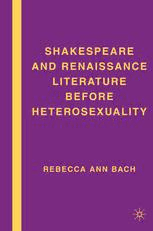
Shakespeare and Renaissance Literature before Heterosexuality PDF
Preview Shakespeare and Renaissance Literature before Heterosexuality
Shakespeare and Renaissance Literature before Heterosexuality Previously Published: Colonial Transformations: The Cultural Production of the New Atlantic World 1580–1640, Palgrave, 2000. Shakespeare and Renaissance Literature before Heterosexuality Rebecca Ann Bach SHAKESPEAREANDRENAISSANCELITERATUREBEFOREHETEROSEXUALITY © Rebecca Ann Bach,2007. Softcover reprint of the hardcover 1st edition 2007 978-1-4039-7654-3 All rights reserved.No part of this book may be used or reproduced in any manner whatsoever without written permission except in the case of brief quotations embodied in critical articles or reviews. First published in 2007 by PALGRAVE MACMILLAN™ 175 Fifth Avenue,New York,N.Y.10010 and Houndmills,Basingstoke,Hampshire,England RG21 6XS Companies and representatives throughout the world. PALGRAVE MACMILLAN is the global academic imprint of the Palgrave Macmillan division of St.Martin’s Press,LLC and of Palgrave Macmillan Ltd. Macmillan® is a registered trademark in the United States,United Kingdom and other countries.Palgrave is a registered trademark in the European Union and other countries. ISBN 978-1-349-53722-8 ISBN 978-0-230-60363-9 (eBook) DOI 10.1057/9780230603639 Library of Congress Cataloging-in-Publication Data Bach,Rebecca Ann. Shakespeare and Renaissance literature before heterosexuality / by Rebecca Ann Bach. p.cm. Includes bibliographical references and index. Contents:Before heterosexuality—The homosocial King Lear :sex, men,and women before the valorization of lust and greed—Restoration Shakespeare 1:adultery and the birth of heterosexuality—Restoration Shakespeare 2:friends and libertines—“Domestic tragedy”and emerging heterosexuality—Othello in the seventeenth and eighteenth centuries and the colonial origins of heterosexuality. 1.English drama—Early modern and Elizabethan,1500–1600—History and criticism.2.Heterosexuality in literature.3.English drama—17th century–History and criticism.4.Heterosexuality—England—History. 5.Shakespeare,William,1564—1616—Criticism and interpretation. 6.Sex in literature.7.Adultery in literature.8.Lust in literature.I.Title. PR658.H44B33 2007 822’.309353—dc22 2006051371 A catalogue record for this book is available from the British Library. Design by Newgen Imaging Systems (P) Ltd.,Chennai,India. First edition:April 2007 10 9 8 7 6 5 4 3 2 1 For Julia This page intentionally left blank Contents Acknowledgments ix Introduction: Before Heterosexuality 1 1 The Homosocial King Lear: Sex, Men, and Women before the Valorization of Lust and Greed 25 2 Restoration Shakespeare 1: Adultery and the Birth of Heterosexuality 49 3 Restoration Shakespeare 2: Friends and Libertines 81 4 “Domestic Tragedy” and Emerging Heterosexuality 107 5 Othelloin the Seventeenth and Eighteenth Centuries and the Colonial Origins of Heterosexuality 153 Notes 183 Bibliography 211 Index 237 This page intentionally left blank Acknowledgments Iam fortunate to have a long list of institutions, colleagues, friends, and family to thank for their contributions (witting and unwitting) to this book. Without the boon of a year-long National Endowment for the Humanities Fellowship at the Newberry Library, I would never have had either the resources or the time to write it. My year at the Newberry (2000–2001) was a delight from start to finish. The staff provided materials, guidance, and general col- legiality in all situations, including an initiatory emergency room visit. Despite my disturbing the peace that way, the staff embraced me from the beginning of my year to the end. Thanks so much to Jim Grossman, Sara Austin, and Hjordis Halvorson, among others. No one at the Newberry was ever anything but a huge help. I could not have accepted that grant from the NEH without the kind cooperation and the sabbatical leave provided by the University of Alabama at Birmingham. In addition, my Dean at UAB provided a grant for travel to the Furness Shakespeare library at the University of Pennsylvania as well as the subvention that enabled me to index the book. I very much appreciate that support. I did the preliminary research for the book and additional research and writing at Furness. Furness and the Walter and Leonore Annenberg Rare Book Library at Penn are glorious places to work, thanks to the depth and breadth of their collections and to their superb staff. I owe thanks in particular to John Pollack, Dan Traister, and Lynne Farrington, who have so amply supported my work over the years. Work at these libraries was made wonderful as well by the people working alongside me. The group of scholars at the Newberry with me fertilized my scholarship and provided care and support as well as extracurricular enrichment. For lunches, dinners, conversations, baseball games, shoe shopping, and general fun, I want to thank April Alliston, Catherine Brown, Alan Frantzen, David Gants, Deborah Kanter, Victoria Kirkham, Ellen McClure, Peggy McCracken, and Carolyn Podruchny. At Furness, I often worked across two desks
